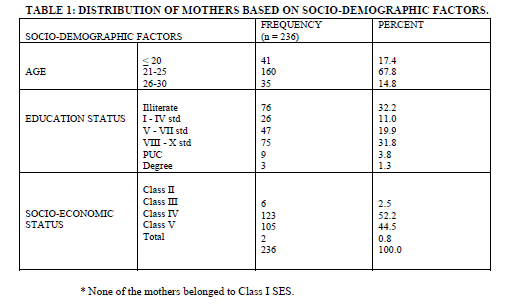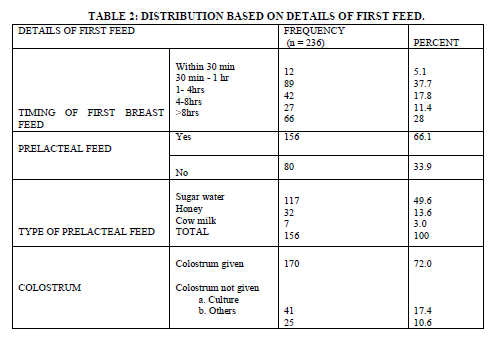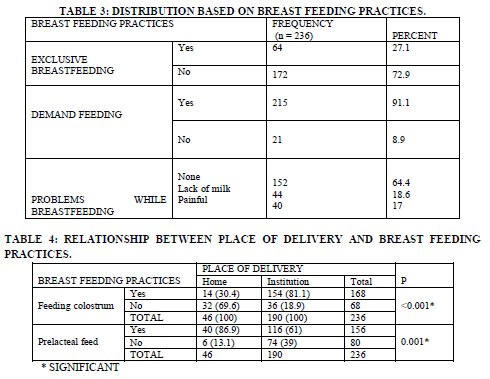IJCRR - 5(21), November, 2013
Pages: 13-18
Date of Publication: 21-Nov-2013
Print Article
Download XML Download PDF
A CROSS-SECTIONAL STUDY ON BREAST FEEDING PRACTICES IN A RURAL AREA OF NORTH KARNATAKA
Author: Bhavana R. Hiremath, M.M.Angadi, Vijaya Sorganvi
Category: Healthcare
Abstract:Objective: To elicit the breastfeeding practices prevalent in this rural backward area Methods: A community based cross sectional study wherein 236 mothers were interviewed regarding their place of delivery and breast feeding practices followed by them. Results: 236 mothers all of whom had a normal delivery were interviewed. 80.5% mothers had delivered in an institution. Only 5.1% mothers initiated breast feeding within half hour of delivery. 66.1% mothers gave prelacteal feeds and 72% gave colostrums to their neonates. Exclusive breast feeding was practiced by 27.1% mothers while 91.1% practiced demand feeding. Conclusion: It is often said that breast feeding is the foremost natural immunisation a baby receives and it saves more lives than any other preventive intervention. Such is the importance of breast feeding and this should be communicated to every woman using the appropriate medium.
Keywords: Colostrum, prelacteal feeds, demand feeding.
Full Text:
INTRODUCTION
Breastfeeding is an unequalled method of providing ideal nutrition for the healthy growth and development of infants. It is a fundamental right of every child. Infants suffer from malnutrition if they do not receive adequate nutrients. Colostrum is the thick yellowish mammary secretion produced immediately after delivery. It protects the infant against infection and lays foundation for the immune system. It is often said that colostrums is the first immunisation that a newborn receives.
Baby Friendly Hospital Initiative was launched by WHO & UNICEF in 1991 as a part of global effort to protect, promote and support Breast feeding.1 Early and Exclusive Breast feeding are components of Essential Newborn Care introduced by World Health Organisation. (2) Government of India introduced Essential Newborn Care under Child Survival and Safe Motherhood Programme in 1992 and it has been a part of RCH programme since 1997.(3)
Breast feeding in India is universal and prolonged but several traditional practices are prevalent which vary among the different regions and communities. Ignorance, lack of awareness regarding importance of breast feeding and deep rooted cultural practices has been passed on for generations. Therefore, this study was undertaken with the objective of eliciting the breastfeeding practices prevalent in this rural backward area.
MATERIALS AND METHODS
A community based cross sectional study was conducted at Shivanagi village which is a rural area in Bijapur, Karnataka. All women who delivered from 1st January 2011 to 31st December 2011 were interviewed at their homes using a pre-
designed proforma. Those mothers who lost their child or not willing to participate were excluded from the study. Total sample size was 242 mothers of whom 6 did not show interest to participate in the study. Hence, 236 mothers were interviewed.
The data was compiled, tabulated and analysed using the Statistical Software SPSS version 16. Statistical tests like mean ± SD, percentages were used to analyze the data. Chi-Square tests were applied wherever necessary. The p - value less than 0.05 was considered statistically significant.
RESULTS
Of the 236 mothers in the present study, majority were in the age group of 21-25 years (67.8%), followed by ≤ 20 years (17.4%) and > 25 years (14.8%). Mean ± S.D. of mothers’ age was 23.11 ± 2.78 years. Out of 236 mothers in the present study, it was seen that 32.2% mothers were illiterate while 3.8% had education up to PUC and a mere 1.3% held a degree. With regards to occupation of the mother, 53.4% were housewives and remaining 46.6% worked as agriculture labourers. (Table 1)
Regarding place of delivery, 80.5% mothers delivered in hospital while remaining 19.5% delivered at home. No complications were noted in any delivery.
Breast feeding practices in this area are very disturbing. Many harmful practices are prevalent which should be addressed at the earliest. Initiation of breast feeding within half hour of delivery was practiced only by 5.1% mothers while 39.4% mothers waited beyond 4 hours. Most mothers (66.1%) were influenced by the traditional practice of giving prelacteal feeds to the neonate. Sugar water was the most common prelacteal feed (49.6%) as it is the most easily available sweetened food. Colostrum was discarded by 28% mothers. (Table 2)
It was discouraging to find that only 27.1% mothers practiced exclusive breast feeding though majority (91.1%) mothers practiced demand feeding. This beneficial practice of demand feeding can be attributed to the notion of rural women that a baby cries only when hungry and the only way to pacify such a child is by feeding him/her. Among 35.6% mothers who had a problem while breast feeding, lack of milk was the most common in 18.6% followed by painful breasts in 17%. (Table 3)
It was distressing to note that hygienic practice of cleaning breasts before feeding the baby was not followed by any mother as they were totally unaware of its importance.
Among 190 institutional deliveries, 81.1% mothers gave colostrums to their neonate and 61% gave prelacteal feeds. Of the 46 home deliveries, 30.4% mothers gave colostrums to their neonate and 86.9% gave prelacteal feeds. The practice of feeding colostrums is higher among mothers who had delivered in an institution compared to home. Harmful practice of giving prelacteal feeds was higher among those mothers who delivered at home. Both these finding were statistically significant. (Table 4)
DISCUSSION
India is a country where breastfeeding is a cultural norm, with every mother fostering a favourable positive attitude towards it. Early initiation was defined as breast feeding within half to one hour of delivery. In this study 42.8% mothers initiated breast feeding within 1hr of delivery which is higher than results of other studies in Uttar Pradesh (36.6% and 37.5% respectively) (4) (5) but low compared to study done in Western Nepal (57.9%).(6)
39.4% mothers delayed breast feeding initiation beyond 4 hours owing to the practice of giving prelacteal feeds to the neonate preferably a sweetened feed. Some also believed the initial milk to be harmful to the baby thereby discarding it and later breastfeeding the baby. Among some mothers initiation of breast feeding was delayed until both the mother and neonate were bathed as a belief of purifying them post delivery. Prelacteal feeds is the main source of infection to the
newborn which was given to 66% newborns in this study which is high compared to studies done in Bangalore (19%)(7) and Western Nepal (23.3%)(6) but low compared to studies done in a rural area of South India (71.8%)(8) and Uttar Pradesh (68%).(5) Lack of hygienic practices among mothers can also lead to infection. Infection leads to malnutrition which forms a vicious cycle endangering the life of the infant. Malnutrition may also be due to poor infant feeding practices, lack of exclusive breast feeding, discarding colostrums, improper posture while feeding and poor maternal knowledge on importance of breast feeding. 72% newborns were given colostrums in this study but this is low compared to studies done in Uttar Pradesh (86.1%),(5) Western Nepal (84.6%)(6) and Bangalore(81%).(7)
The National Guidelines on Infant and Young Child Feeding recommend exclusive breastfeeding for the first six months of life and then supplemented breastfeeding up to the age of two years or beyond.9 It was discouraging to note that exclusive breast feeding was practiced only in 27.1% newborns which is low compared to studies done in Bangalore (40%)(7) and Kanpur (51%). (10)
According to the recently developed child growth standards of WHO, 39% of children below 6months of age are underweight. (11) This finding indicated problems while feeding children below 6months of age. 35.6% mothers faced problems while breast feeding like lack of milk (18.6%), pain and tenderness in breasts (17%). In a study conducted in Andhra Pradesh, 65.6% mothers cited insufficient milk production as the main problem. (12)
86.9% mothers who underwent home delivery gave prelacteal feeds to their neonates compared to 61% mothers with institutional delivery. This highlights the importance of focussing on improving number of institutional deliveries. It was tragic to note that inspite of institutional delivery, 18.9% mothers did not give colostrums to the newborns. The health care services and advice given to mothers by the health professionals especially in rural areas should be enhanced in order to uproot these traditional practices. Health education should focus on ridding the community of such harmful practices and encourage institutional delivery and appropriate breast feeding practices. It is rightly said that breast feeding saves more lives than any other preventive intervention.
CONCLUSION AND RECOMMENDATIONS
Behavioural Change Communication (BCC) is essential for appropriate breast feeding practices. Counselling sessions should be directed towards women especially in rural areas so as to improve the breast feeding practices as well as infant and young child feeding practices. Hygienic practices should be encouraged among these women. Breast feeding programs and health workers should take into account traditional beliefs and concepts when communicating with families and emphasize the value of breastfeeding for mothers as well as children. Peer counselling and peer support groups should be developed in these areas.
ACKNOWLEDGEMENT
I would like to take this opportunity to thank all the mothers who consented to participate in this study. I also extend my gratitude to the anganwadi workers and ASHA workers who accompanied me to the houses of the participants. I would also like to thank my department faculty and institution who supported me during the course of this study.



References:
- World Health Organization, UNICEF. Baby-Friendly Hospital Initiative 2009: Revised, updated and expanded for integrated care.
- World Health Organization. Report of the Division of Child Health and Development 1996-97. WHO: Geneva; 1998
- Basic Guide to Reproductive and Child Health Programme. Department of Family Welfare, Government of India.
- Gupta P, Srivastava VK, Kumar V, Jain S, Massod J, Ahmad N, Srivastava JP: Newborn care practices in urban slums of Lucknow City, UP: Indian Journal Of Community Medicine: 2010; 35(1).
- Singh S, Jain DC, Singh M: Determinants of utilization of Maternal and Child health services in a rural area of Uttar Pradesh, (India): Indian Journal of Maternal and Child Health: 2010; 12(4).
- Sreeramareddy CT, Joshi HS, Sreekumaran B V, Giri S, Chuni N. Home delivery and newborn care practices among urban women in western Nepal: a questionnaire survey. BMC Pregnancy and Childbirth: 2006; 6;27.
- Madhu K, Chowdary S, Masthi R. Breast feeding practices and newborn care in rural areas: A descriptive cross-sectional study. Indian J Community Med 2009:34;243-6.
- Yerpude P, Jogdand K: A study on delivery and newborn care practices in a rural area of South India : Indian Journal Of Maternal And Child Health: 2010;12(4).
- Govt of India. National Guidelines on Infant and young child feeding: 2nd edition:2006;
- Department of Women and Child Development, Govt of India.
- Midha T, Nath B, Kumari R, Goyal P, Pandey U: Breastfeeding Practices in Rural Kanpur – A Cross-sectional Study: Indian Journal Of Maternal And Child Health:2010;12(1).
- Deshmukh PR, Dongre AR, Gupta SS, Garg BS. Implications of newly developed growth standards. Indian J Pediatr 2007;74:17-20.
- Takalkar Anant A, Saiprasad G S, Tarun Kumar, Madhekar Narendra S. Breastfeeding Practices in Rural Community of Andhra Pradesh; Indian journal of Maternal and Child Health; 12 (2)
|






 This work is licensed under a Creative Commons Attribution-NonCommercial 4.0 International License
This work is licensed under a Creative Commons Attribution-NonCommercial 4.0 International License